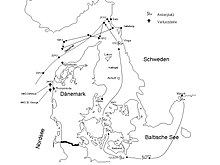HMS Defence (1763)
Battle of the Glorious First of June 1794, dismasted and with severe injury to the hull, by Nicholas Pocock
| |
| History | |
|---|---|
| Name | HMS Defence |
| Ordered | 15 December 1758 |
| Builder | Plymouth Dockyard |
| Launched | 31 March 1763 |
| Fate | Wrecked, 24 December 1811 |
| Notes |
|
| General characteristics [1] | |
| Class and type | Bellona-class ship of the line |
| Tons burthen | 1,6038⁄94 (bm) |
| Length | 168 ft (51.2 m) (gundeck) |
| Beam | 46 ft 9 in (14.2 m) |
| Draught | 21 ft 6 in (6.6 m) |
| Depth of hold | 19 ft 9 in (6.0 m) |
| Sail plan | Full-rigged ship |
| Armament | |
HMS Defence was a 74-gun
Career
During the

Recommissioned into the Channel Fleet under Captain
Defence was at
In 1798 she returned to the Mediterranean under Captain John Peyton, taking part in the Battle of the Nile in August.
On 1 July 1800, Defence,
In 1801, Defence sailed to the Baltic under Captain
In 1805 she saw action again at the Battle of Trafalgar, where under Captain George Johnstone Hope, she captured the San Ildefonso and fought the Berwick, suffering 36 casualties.
Defence was one of the British ships in support of the 1809 Walcheren Campaign which was intended to capture Vlissingen (Flushing) and Antwerp in the Netherlands.
Loss

She ran aground on 24 December 1811 off the west coast of Jutland, Denmark. She was under the command of Captain D. Atkins and in the company of St George, under Rear-Admiral Robert Carthew Reynolds, and Cressy, when a hurricane and heavy seas came up. St George was jury-rigged and so Atkins refused to leave her without the admiral's permission. As a result, both were wrecked near Ringkøbing. Cressy did not ask for permission and so avoided wrecking.[5]

Defence lost all but 14 of her crew of 597 men and boys, including her captain.[5] St George too lost almost her entire crew, including the admiral. Most of the bodies that came ashore were buried in the sand dunes of Thorsminde, which have been known ever since as "Dead Mens Dunes".[5] The Danish authorities quickly ordered Lieutenant Wigelsen to the area as Receiver of Wreck
Captain Atkins and his culpability for the loss
Captain David Atkins is first noted as a
]Accounting for blame for the loss is conflicted. Some say he followed HMS St George onto the reef. As published by Brenton 3 Brenton (1837) Naval History of Great Britain the St George, bearing the flag of Rear-Admiral Robert Carthew Reynolds, ran ashore. Ostensibly, when told of this, Atkins asked whether the admiral had made the signal giving him leave to part company. Hearing a denial, Atkins said: "I will never desert my Admiral in the hour of danger and distress." Defence ran aground and was overcome by a breaking sea. The breakup led to loss of 593 men, her full complement being 597.[6] One of the survivors said that "At half-past twelve the captain told Mr. Baker he would not wear till the St. George did, but would stay by her."[11]
On the other hand, the Annual Register (Vol 54), however, states that HMS Defence was the first ship to run aground and that HMS St George (flagship) immediately let go its anchor but that the ship swung around on her cable and also went aground as a result." This account was corroborated by an account printed in
Atkins' body was buried with full
Notes
Citations
- ^ Winfield (2008), p. 43.
- ^ "No. 15407". The London Gazette. 15 September 1801. p. 1145.
- ^ a b Debritt (1801), Appendix:History of the war page 37.
- ^ "No. 18160". The London Gazette. 30 July 1825. p. 1337.
- ^ a b c Gosset (1986), p. 81.
- ^ . Retrieved 4 April 2018.
- ISBN 9780811711111.
- Markham, Clements Robert; Mahan, Alfred Thayer; Wilson, Herbert Wrigley (1900). The Royal Navy: A History from the Earliest Times to the Present. Vol. 5. S. Low, Marston. p. 498.
- ^ Gilly, William Stephen (1864). Narratives of Shipwrecks of the Royal Navy Between 1793 and 1857 Compiled Principally from Official Documents in the Admiralty (3rd ed.). Longman, Green, Longman, Roberts and Green. p. 376.
- ISBN 0719120330.
- ^ The Naval Chronicle, Vol 28 p 210
References
- Debritt, J. (1801). A Collection of State Papers Relative to the War Against France Now Carrying on by Great Britain and the Several Other European Powers ... A Collection of State Papers Relative to the War Against France Now Carrying on by Great Britain and the Several Other European Powers. J. Debrett.
- Gosset, William Patrick (1986). The lost ships of the Royal Navy, 1793-1900. Mansell. ISBN 0-7201-1816-6.
- Winfield, Rif (2008). British Warships in the Age of Sail 1793–1817: Design, Construction, Careers and Fates. Seaforth Publishing. ISBN 978-1-86176-246-7.
External links
 Media related to HMS Defence (1763) at Wikimedia Commons
Media related to HMS Defence (1763) at Wikimedia Commons- Ships of the World (via archive.org)
- http://strandingsmuseet.dk
- Thorsminde on Danish Wikipedia
